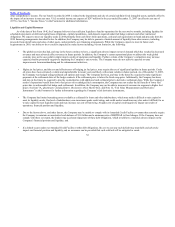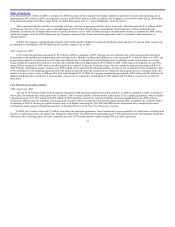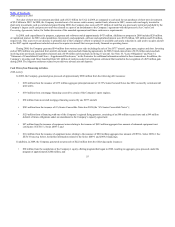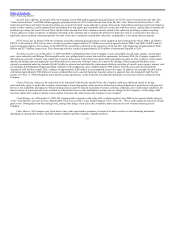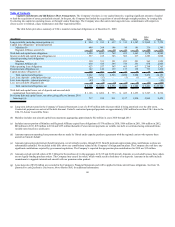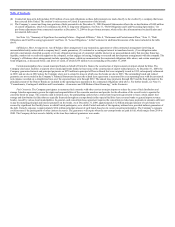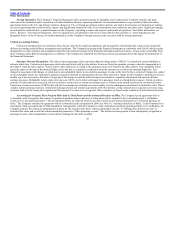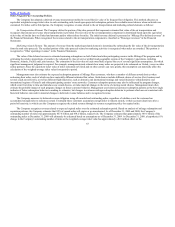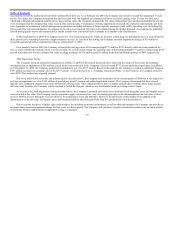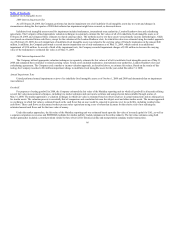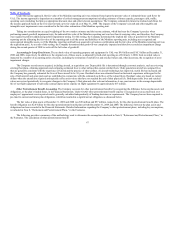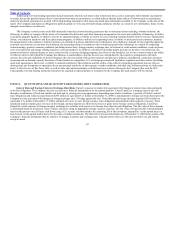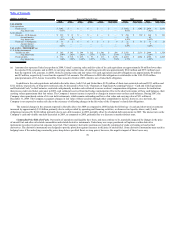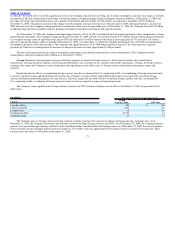United Airlines 2009 Annual Report Download - page 65
Download and view the complete annual report
Please find page 65 of the 2009 United Airlines annual report below. You can navigate through the pages in the report by either clicking on the pages listed below, or by using the keyword search tool below to find specific information within the annual report.
Table of Contents
(h) Contractual long-term debt includes $109 million of non-cash obligations as these debt payments are made directly to the creditor by a company that leases
three aircraft from United. The creditor’s only recourse to United is repossession of the aircraft.
(i) The Company’s current and long-term portions of debt presented in its December 31, 2009 Financial Statements reflects the reclassification of $449 million
of current obligations, which were refinanced in 2010, to long-term obligations. See Note 11, “Debt Obligations and Card Processing Agreements,” for
pro-forma adjustments from contractual maturities at December 31, 2009 to the pro-forma amounts, which reflect the aforementioned reclassification and
incremental debt issued.
See Note 1(i), “Summary of Significant Accounting Policies—Regional Affiliates,” Note 8, “Retirement and Postretirement Plans,” Note 11, “Debt
Obligations and Card Processing Agreements” and Note 14, “Lease Obligations,” in the Footnotes for additional discussion of the items included in the table
above.
Off-Balance Sheet Arrangements. An off-balance sheet arrangement is any transaction, agreement or other contractual arrangement involving an
unconsolidated entity under which a company has (1) made guarantees, (2) a retained or a contingent interest in transferred assets, (3) an obligation under
derivative instruments classified as equity or (4) any obligation arising out of a material variable interest in an unconsolidated entity that provides financing,
liquidity, market risk or credit risk support to the company, or that engages in leasing, hedging or research and development arrangements with the company. The
Company’s off-balance sheet arrangements include operating leases, which are summarized in the contractual obligations table above, and certain municipal
bond obligations, as discussed below, and letters of credit, of which $274 million were outstanding at December 31, 2009.
Certain municipalities have issued municipal bonds on behalf of United to finance the construction of improvements at airport-related facilities. The
Company also leases facilities at airports where municipal bonds funded at least some of the construction of airport-related projects. At December 31, 2009, the
Company guaranteed interest and principal payments on $270 million in principal of Denver Bonds that were originally issued in 1992, subsequently refinanced
in 2007, and are due in 2032 unless the Company elects not to extend its lease in which case the bonds are due in 2023. The outstanding bonds and related
guarantee are not recorded in the Company’s Financial Statements because the related lease agreement is accounted for as an operating lease with the associated
rent expense recorded on a straight-line basis over the expected lease term through 2032. The annual lease payments through 2023 and the final payment for the
principal amount of the Denver Bonds are included in the operating lease payments in the contractual obligations table above. For further details, see Note 13,
“Commitments, Contingent Liabilities and Uncertainties—Guarantees and Off-Balance Sheet Financing,” in the Footnotes.
Fuel Consortia. The Company participates in numerous fuel consortia with other carriers at major airports to reduce the costs of fuel distribution and
storage. Interline agreements govern the rights and responsibilities of the consortia members and provide for the allocation of the overall costs to operate the
consortia based on usage. The consortia (and in limited cases, the participating carriers) have entered into long-term agreements to lease certain airport fuel
storage and distribution facilities that are typically financed through tax-exempt bonds (either special facilities lease revenue bonds or general airport revenue
bonds), issued by various local municipalities. In general, each consortium lease agreement requires the consortium to make lease payments in amounts sufficient
to pay the maturing principal and interest payments on the bonds. As of December 31, 2009, approximately $1.2 billion principal amount of such bonds were
secured by significant fuel facility leases in which United participates, as to which United and each of the signatory airlines have provided indirect guarantees of
the debt. United’s exposure is approximately $214 million principal amount of such bonds based on its recent consortia participation. The Company’s exposure
could increase if the participation of other carriers decreases. The guarantees will expire when the tax-exempt bonds are paid in full, which ranges from 2010 to
2040. The Company did not record a liability at the time these indirect guarantees were made.
61



